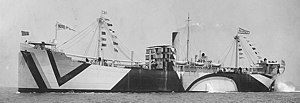Design 1015 ship
World War I steel-hulled cargo ship design From Wikipedia, the free encyclopedia
The Design 1015 ship (full name Emergency Fleet Corporation Design 1015) was a steel-hulled cargo ship design approved for production by the United States Shipping Board's Emergency Fleet Corporation (EFT) during World War I.[1] They were referred to as the "Moore & Scott"-type.[1]
 SS Alloway (1918) | |
| Class overview | |
|---|---|
| Name | EFT Design 1015 |
| Built | 1918–21 (USSB) |
| Planned | 89 |
| Completed | 84 (1 delivered incomplete) |
| Cancelled | 5 |
| General characteristics | |
| Type | Cargo ship |
| Tonnage | 9,400 dwt |
| Length | 402 ft 0 in (122.53 m) |
| Beam | 53 ft 0 in (16.15 m) |
| Draft | 32 ft 0 in (9.75 m) |
| Propulsion | Triple expansion engine or turbine, oil fuel[1] |
They were mostly built at West Coast yards:[1]
- Groton Iron Works, Groton, Connecticut, 6 ships, 3 cancelled, 3 completed
- Moore Shipbuilding and Drydock Company, Oakland, California, 26 ships of which 8 were converted to reefers, no cancellations
- Pacific Coast Shipbuilding Company, Bay Point, California, 10 ships, no cancellations
- Seattle North Pacific Shipbuilding Company, Seattle, Washington, 10 ships, no cancellations
- G. M. Standifer Construction Company, Vancouver, Washington, 15 ships, no cancellations
- Union Construction Comapany, Oakland, California, 10 ships, no cancellations
- Virginia Shipbuilding Company, Alexandria, Virginia, 12 ships, 2 cancelled, 9 completed, 1 partially completed
References
Bibliography
External links
Wikiwand - on
Seamless Wikipedia browsing. On steroids.
